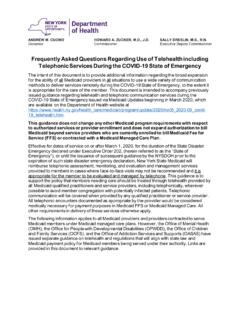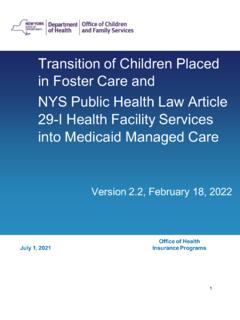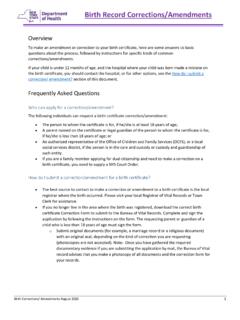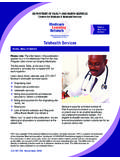Transcription of 1115 Waiver Demonstration: Conceptual Framework A …
1 YORK STATE Department of Health Office of Health lnsuranc Programs 1115 Waiver demonstration : Conceptual Framework A Federal-State Partnership to Address Health Disparities Exacerbated by the COVID-19 Pandemic New York State Department of Health Office of Health Insurance Programs One Commerce Plaza Albany, NY 12207 August 2021 1 Table of Contents Executive Summary .. 3 Background and Context: Lessons Learned from the COVID-19 Pandemic .. 4 Relationship with Larger 1115 Waiver and DSRIP .. 6 Initiatives & Investments Proposed by Waiver Goals .. 6 Goal #1: Building a more resilient, flexible and integrated delivery system that reduces racial disparities, promotes health equity, and supports the delivery of social 7 Investments in Regional Planning through HEROs.
2 9 Investments in Social Determinant of Health Networks (SDHNs) Development and 13 Investments in Advanced VBP Models that Fund the Coordination and Delivery of Social Care via an Equitable, Integrated Health and Social Care Delivery System .. 16 Capacity Building and Training to Achieve Health Equity Goals .. 19 Ensuring Access for Criminal Justice-Involved Populations .. 20 Goal #2: Developing Supportive Housing and Alternatives to Institutions for the Long-Term Care 22 Investing in Home and Community-Based Services as Alternatives to Institutional Settings .. 23 Specific Supports for Individuals with Behavioral Health and Substance Use Disorder Needs .. 25 Goal #3: Redesign and Strengthen Health and Behavioral Health System Capabilities to Provide Optimal Response to Future Pandemics & Natural Disasters.
3 26 Pandemic Response Redesign .. 26 Develop a Strong, Representative and Well-Trained Workforce .. 27 Goal #4: Creating Statewide Digital Health and Telehealth 29 Budget Neutrality and Sources of Financing .. 31 2 A Federal-State Partnership to Address Health Disparities Exacerbated by the COVID-19 Pandemic Executive Summary New York State (NYS or the State) requests $17 billion over five (5) years to fund a new 1115 Waiver demonstration that addresses the inextricably linked health disparities and systemic health care delivery issues that have been both highlighted and intensified by the COVID-19 pandemic. The COVID-19 pandemic devastated many vulnerable populations of Medicaid recipients, with a particularly detrimental impact to populations with historical health disparities, including persons living in poverty, Black and Latino/Latinx and other underserved communities of color, older adult populations, criminal justice-involved Definitionspopulations, high-risk mothers and children, persons with A widely used definition of healthintellectual and developmental disabilities (I/DD), persons equity is the one developed and used living with severe mental illnesses, persons with substance by the Robert Wood Johnson use disorders, and persons experiencing homelessness.
4 Foundation (RWJF): Health equity Understanding that health disparities differ by population, means that everyone has a fair and geography, and previous community investment, calls for just opportunity to be as healthy as a tailored approach based on these factors. possible. This requires removing obstacles to health such as poverty, Addressing health equity and achieving an equitable discrimination, and their consequences, including recovery from the COVID-19 pandemic, while advancing powerlessness and lack of access to other long-standing delivery system reform goals of NYS, good jobs with fair pay, quality is a complex undertaking and requires a transformational, education and housing, safe coordinated effort across all sectors of the health care environments, and health care.
5 Delivery system and continuum of social services. Indeed, to address the full breadth of factors contributing to health The Centers for Disease Control and disparities, NYS will not only pursue reforms and Prevention (CDC) defines health investment in the health care delivery system, but also in disparities as: preventable training, housing, job creation, and many other areas. differences in the burden of disease, Accordingly, if approved, this Waiver reflects that injury, violence, or in opportunities achieving an equitable recovery from COVID-19 is a to achieve optimal health experienced by sociallyprocess, not just an outcome, and would be just one part disadvantaged racial, ethnic, andof NYS s intertwined Reimagine, Rebuild, Renew other population groups, and initiatives that collectively form a unified statewide communities.
6 Strategy for equitable COVID-19 recovery. At the same time, because health and healthcare are local and the social service offerings may differ by region, this statewide strategy must also tie back to local gaps and needs, particularly for the health care safety net. Accordingly, NYS proposes an ambitious partnership with the Federal government through an 1115 Waiver demonstration that creates a pathway to address and rectify these historic health disparities. This partnership is critical to addressing health disparities exacerbated by COVID-19, promoting health equity, and fulfilling the promise of the Medicaid program to provide comprehensive health benefits to those who need them. 3 If approved, this 1115 Waiver demonstration would utilize an array of multi-faceted and linked initiatives in order to change the way the Medicaid program integrates and pays for social care and health care in NYS.
7 It would also lay the groundwork for reducing long standing racial, disability-related and socioeconomic health disparities, increase health equity through measurable improvement of clinical quality and outcomes, and keep overall Medicaid program expenditures budget neutral to the federal government. To achieve this overall goal of fully integrating social care and health care into the fabric of the NYS Medicaid program, while recognizing the complexity of addressing varying levels of social care needs impacting the Medicaid population, this Waiver proposal is structured around four subsidiary goals: 1. Building a more resilient, flexible and integrated delivery system that reduces racial disparities, promotes health equity, and supports the delivery of social care; 2. Developing supportive housing and alternatives to institutions for the long-term care population; 3.
8 Redesigning and strengthening health and behavioral health system capabilities to provide optimal response to future pandemics and natural disasters; and 4. Creating statewide digital health and telehealth infrastructure Background and Context: Lessons Learned from the COVID-19 Pandemic Since the inception of New York s 1115 Waiver in 1997, New York has invested in and fortified one of the most comprehensive Medicaid programs in the country, and has frequently been among the first states to expand eligibility or incorporate enhanced benefits. The Medicaid program, combined with other state-supported health insurance options offered through the widely recognized NY State of Health Marketplace such as the Essential Plan and Child Health Plus, provides comprehensive coverage to nearly all low-income New Yorkers.
9 The comprehensiveness, value and accessibility of the Medicaid program has never been more important than during the COVID-19 pandemic. As the Centers for Medicare and Medicaid Services (CMS) is aware, the COVID-19 crisis hit New York first and hardest. The first confirmed COVID-19 case in New York occurred on March 1, 2020. Six weeks later, there were 18,825 COVID patients in New York At the peak of the pandemic, epidemiological models indicated that the State required inpatient capacity of anywhere from 55,000 to 136,000 1 New York Forward, Daily Hospitalization Summary by Region, available at 4 beds for COVID-19 At the same time, public health authorities lacked extensive clinical and epidemiological knowledge about the treatment and spread of the disease, and health care workers faced rampant shortages of protective equipment.
10 The State had to implement an emergency pause of the economy, enact immediate regulatory relief to facilitate care, and coordinate an operational response, all in real-time. Responding to COVID-19 taught NYS critical lessons about coordinating an effective and massive response within the existing health care system, from ramping up the availability of testing to bringing hospital resources and staff to high-priority regions. During these efforts, losses in employer-sponsored coverage or changes in economic status resulted in the Medicaid program extending health coverage to more than 888,000 additional New Yorkers, growing from over six million enrollees in March 2020 to approximately seven million in March 2021. Notwithstanding these successes in the mobilization of New York s pandemic response and the ability of the State s Medicaid program to absorb a tremendous influx of new enrollees, the pandemic revealed that even an immediate, effective emergency response was insufficient to overcome a long history of policies and practices in the that have contributed to inequity in health care and significant health disparities.















